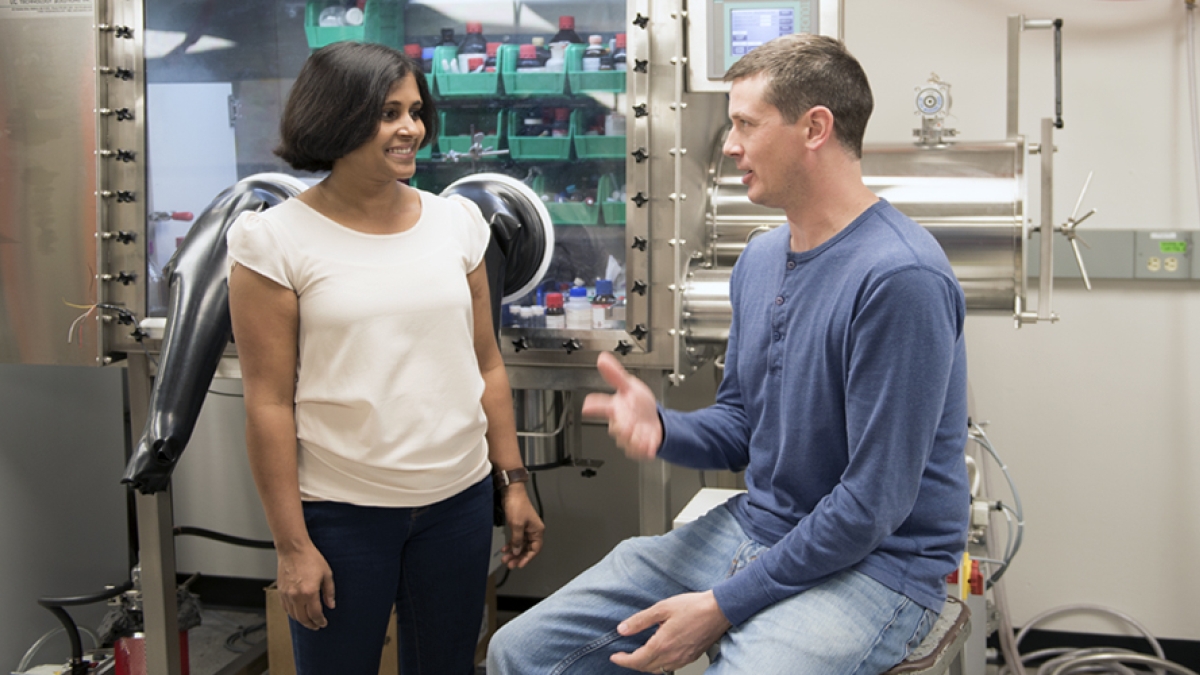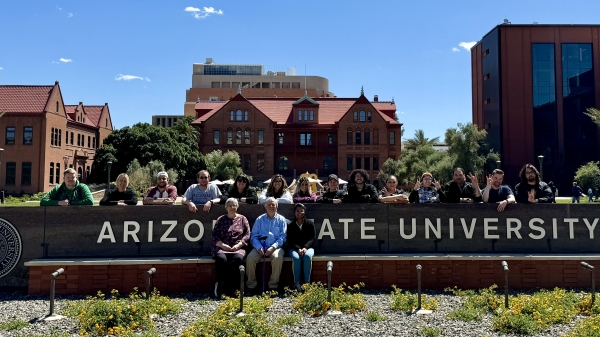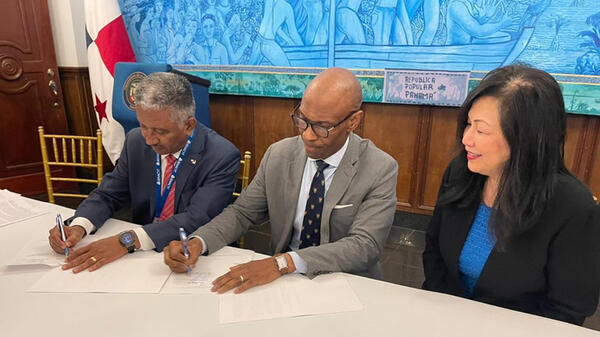ASU group developing cost-effective way to trap power plants' carbon dioxide emissions
Professor Dan Buttry and School of Molecular Sciences team describe new methods in article chosen as American Chemical Society 'Editor's Choice'

Associate research scientist Poonam Singh and graduate student Joseph Rheinhardt from ASU professor Dan Buttry's research group.
Controlled capture and release of carbon dioxide emitted from power plants represents a potential method for reducing the buildup of this greenhouse gas in the atmosphere. Existing chemical methods for doing so, however, consume large amounts of energy and are not technologically viable.
In a recent perspective article in the journal American Chemical Society Energy Letters, Arizona State University professor Dan Buttry and his group in the School of Molecular Sciences describe new methods that have the potential to reduce these energy costs by more than half. The article was selected for highlighting as an American Chemical Society "Editors Choice" article.
Buttry, graduate student Joseph Rheinhardt, associate research scientist Poonam Singh and associate research professor Pilarisetty Tarakeshwar are developing efficient and cost-effective carbon capture technologies that use innovative electrochemical techniques to separate the greenhouse gas carbon dioxide from other emissions from power plants. Trapping carbon dioxide this way allows it to be collected for transportation and/or burial or permanent sequestration, in order to prevent its accumulation in the atmosphere.
A new approach
"The effort is focused on a key issue in fossil fuel-based energy production — how to reduce atmospheric carbon dioxide emissions without consuming too much of the energy content of the fuel,” said Buttry. "We have recently developed a new approach to carbon dioxide capture that uses an electrochemical process with some design features similar to those in a fuel cell.”
Understanding the chemistry of carbon dioxide is key to controlling its release into the atmosphere. Most carbon dioxide capture methods involve thermal cycles in which a specially designed chemical agent removes carbon dioxide from impure gas streams (e.g., power station flue gas), followed by second thermal chemical reaction in which the captured carbon dioxide is released in pure form.
Plant scale demonstrations based on this technology use compounds called amines as the trapping agents in the so-called monoethanolamine (MEA) process. The MEA process has several drawbacks; specifically, the energy required for the thermal release of the captured carbon dioxide. As discussed in a recent Department of Energy report (DOE/NETL-2009/1366), the energy required for the release process consumes roughly 40 percent of total plant output, and increases the cost of electricity by 85 percent.
In the published article in ACS Energy Letters, the Buttry group describes a different strategy based on electrochemical cycles to capture and release carbon dioxide. These cycles rely on electrochemical generation of the chemical trapping agent. The carbon dioxide is subsequently released in pure form in a second electrochemical step.In the article in Energy Letters, Buttry et al. describe different examples of this new electrochemical cycle for carbon dioxide capture and release, and the advantages and disadvantages inherent in this general approach: "Electrochemical Capture and Release of Carbon Dioxide" ACS Energy Lett., 2017, 2(2), pp 454–461: DOI: 10.1021/acsenergylett.6b00608.
Where solutions happen
The School of Molecular Sciences and Arizona State University has been building its portfolio in alternative energy research for several years, and currently includes among its capabilities a center for research into electrochemical approaches for renewable energy applications; several advanced programs on photosynthesis and solar energy research; one of the leading testing and certification centers for solar energy; and research into solar-generated biofuels, including advanced work on algae-based biofuels: https://sms.asu.edu/research/research-areas/molecular-energy-and-catalysis.
More Science and technology

ASU expands hands-on lab opportunities for online biochemistry students
As a New York City autopsy research coordinator, Stephanie McQuillan saw her continued education as a gateway for career…

Blueprints of self-assembly: New design technique advances nanotechnology
Many biological structures of impressive beauty and sophistication arise through processes of self-assembly. Indeed, the natural…

ASU assists Panamanian microelectronics development efforts
Arizona State University continues to expand its efforts to support the development of the semiconductor workforce and supply…